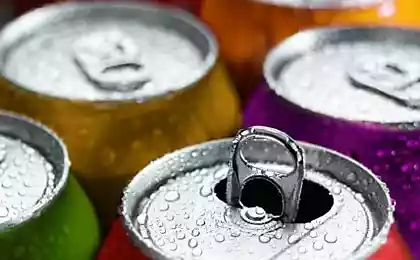969
The most incredible alcoholic beverages
... The Chinese wine infused with newborn rat pups, does exist - and, moreover, is a traditional Chinese products with a rich history. Pups poured rice wine and leave to infuse for a year. In China and Korea believe that the thus obtained drink has miraculous healing properties and cures all ...
Fortunately, with the help of the Internet it is impossible to drink, and the world is still full of alcoholic beverages, which can not try anywhere but in their homeland. Some of these drinks can not be transported, while others are manufactured offensively small circulation, others are so amazing that they dare to drink a few.
And together they add up to an alternate universe of alcohol where drinking - it is still a private affair a person with a glass at the bar. Even if the role of the bar covered with clay takes the table, instead of a glass - wooden circle, and splashing in her drink from fermented millet. Forbes.ru chose 10 of the most bizarre world of alcoholic beverages, which are worth a try.

Karlsson's Vodka (Sweden)
Strength: 40 degrees
Price: $ 40
Manufacturer Website: www.karlssonsvodka.com
This Swedish vodka made entirely of Swedish potatoes and, most importantly, on the patterns of wine production: that is, taking into account the terroir, variety of potatoes and crop year. Karlsson's Gold came up with one of the creators of Absolut vodka Borje Karlsson; He came up with the Swedish potato called "golden grapes Swedish land." It is in every sense a contemporary product, rethink all the basic principles of vodka mythology. Standard vodka must not be my taste - Karlsson's, by contrast, emphasizes the difference flavors of different harvest years. In line Karlssons Vintage far presented three years (2004, 2005 and 2006), and there are both single-malt varieties (made from one type of potato) and mixed blends (Karlssons Gold and Karlssons Gold 25). In particular, there is a vodka made from potatoes, young, growing at Cape Biar.
Each bottle is numbered, each attached to a booklet identifying the locus of potatoes, variety of features, the history of the farm-products and a description of the weather in a given year. Beta testers assured that the taste of vodka of different years and even more made from different varieties really are very different: some more earthen tones, others - fruit.
While Karlsson's just beginning to conquer the world market, but has managed to make some noise in New York, where she served in the trendy East Village bars - mainly due to the benevolent reviews in the New York Times. By the way, for the faint of heart apocryphal Karlsson produces 25-degree version of its potato product.
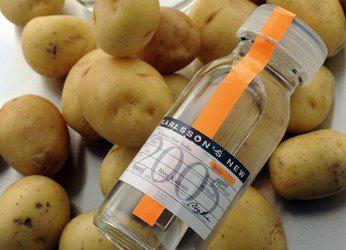
Bilk (Japan)
Strength: 5 degrees
Price: ¥ 380
Manufacturer Website: www.takahasi.co.jp
Japan holds a confident first place on the number of drinks that can unpleasantly surprise of Western man. It is a country where there is a cucumber "Pepsi", and Coca-Cola produces soda aroma of green salad. There is - and is a success - a drink that imitates the taste of mother's milk, pop flavored eel and low-calorie drink from pig placenta with peach flavor (it is believed that it improves the complexion). Is your marketing findings in the beer industry: very good selling non-alcoholic "beer baby» (Kid's Beer) with a cheerful baby on the label, beer flavored chocolate and regional beer with small sardines from Kanagawa Prefecture.
However, louder than the others were able to express themselves brewers from Hokkaido who produced milk beer Bilk, made up two-thirds of the beer, and a third - from milk. He invented a new beer son of the manager of alcohol shops in nakashibetsu when in March 2006 on dairy farms of Hokkaido happened overproduction of milk. The young man decided to rectify the situation and agreed with the brewery Abashiri Beer, famous for its colored beers - blue, green and red. Beer with milk, require the development of a fairly complex formulation (the milk, low boiling point and high starch content, so that they replace the water was not easy), suddenly received a warm welcome by the locals. Milk beer was considered an easy, enjoyable drink, bringing junk milk have been saved, and the brand Bilk suddenly resounded all over the world.
However, this International triumph awaits him almost: taking the English title (Bilk - this beer + milk), the Japanese are traditionally lazy to look into the English vocabulary: the verb to bilk means "puff", "obegorivat."

Sam Adams Utopia Beer (US)
Strength: 27 degrees
Price: $ 150
Manufacturer Website: www.samueladams.com
This beer is sold under the slogan "the strongest beer in the world" - it 27 degrees. American Brewery Boston Beer Company has long been experimenting in this genre: to release them Utopia Beer brewed beer Triple Bock, and Millenium with an alcohol content of 17, 5 and 21 degrees, respectively. Beer Utopia appeared in 2002 and at first was issued fortress 24 degrees, but then the Brewers added three more.
Of course, this beer is not too similar to beer - it is positioned as a digestif, and the taste is more like a bitter busy port. It is brewed from Vienna, Moravian and Bavarian malts and four kinds of hops with the addition of maple syrup and then aged at least a year in barrels of cognac, port and sherry. This small run beer: in 2009 it was brewed about 53 barrels (12 000 bottles). Utopia Beer is produced in special flasks capacity 0, 75 l, resembling copper beer kegs, and sold an average of $ 150. It occurs infrequently, in addition to the 14 states a beer of this strength may not be sold legally.
It is worth mentioning that the title "the strongest beer in the world" for marketing reasons are trying to seize other brewery - especially eloquent fight Schorshbrau German brewery Scottish and Brew Dog. In December last year released Schorshbrau beer strength of 40 degrees, Brew Dog in May 2010, killed their rate 41-degree beer with a suitable name Sink the Bismarck, and in the same month Schorshbrau said 43-degree Schorschbock. In the world of brewers of this arms race watched with interest, but beer lovers have not yet decided whether it is worth to consider these drinks beer.
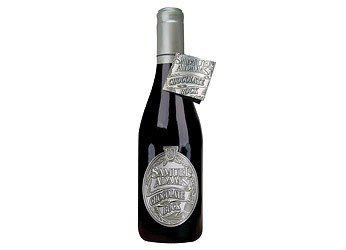
Mamma Mia Pizzabeer (US)
Strength: 4, 6 degrees
Price: $ 2, 50
Another specific Hand crafting a beer - this time with the taste of pizza. This product is a small family brewery from Illinois, whose owners - Tom and Athena Sifurt - do not hide that inspired book Radical Brewing Chicago designer and amateur brewer Randy Mosher. Largely because of the influence of Mosher in America spread the fashion for private brewery experimenting with the recipes - they brew a beer with maple syrup, pepper, coriander, hemp, honey and garlic (from Mosher, by the way, are mentioned far more strange things: mushrooms, Crab eyes and heated pebbles).
Mamma Mia Pizzabeer - is, strictly speaking, a beer flavored oregano, tomatoes, garlic and basil. The oddity is that in its manufacture couple Sifurtov does use a pizza margarita. Freshly milled pizza to mush, put into a linen bag and a long brewed in boiling water as a tea bag. Then infusion of drained and cooked it more or less classic ale. Almost all tried Mamma Mia Pizzabeer celebrate strong and instantly recognizable scent of pizza - and even stronger garlic aftertaste.

Spruce beer (Canada)
Strength: 5 degrees
Price: $ 5, 80
Manufacturer Website: www.wigrambrewing.co.nz
In spruce beer - a beverage brewed from fresh twigs containing added sugar or molasses - a long history: until the beginning of the XX century it actively brewed in America, Canada, Scotland and Scandinavia. Spruce beer made with sugar on his ship even Captain Cook believes that it is very good for scurvy. In spruce beer was excellent reputation: in the XVIII century it was supplied to the army battalions, and its preferred rum. A letter of the British Vice Admiral Samuel Graves, dated 1775 the year in which he urges the soldiers and sailors drink is beneficial to the health of spruce beer, not rum, awakens in man the most evil tendencies.
In the French provinces of Canada spruce beer brewed privately until 1940, and later the Canadian branch of the "Phantom" even let fir non-alcoholic drinks, and many Quebecers that taste is still strongly associated with childhood. Today, their business continues to small Canadian company Marco Beverages, making pop tastefully pine branches.
But now spruce beer brewery brews only one in the world - New Zealand Wigram Brewing Co: they claim that it is using the recipe in 1773. This dense drink with a very strong smell of pine and unexpected taste of tea (as part of the beer there Manuka tea tree). Despite running a viral advertising that tried to promote spruce beer as a national drink of New Zealand, it is a hit or not, and in one of the reviews called it "a cocktail of toothpaste, damp marsh tea and sleep."
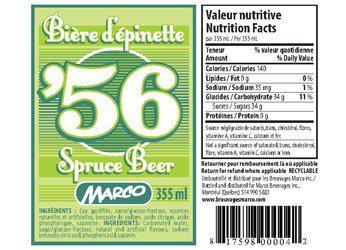
Chicha (Latin America)
Strength: 3-50 degrees
Price: depending on the country, the quality and strength of the drink
This is a very ancient drink - drank more Incas. On the antiquity points and the method of production: in the traditional version of the woman chewed dry grain maize yellow or purple, and the resulting mass is poured with water and left to ferment until the desired fortress. Enzymes in the saliva digested corn starch, turning it into maltose - so (chewing grains) used to do, and many other beverages, such as sake.
Species chicha there are so many. In the Amazon chicha made from cassava, chicha in Bolivia cook amaranth in Colombia and Ecuador - from quinoa, rice and pineapples. Most rare variety - "chicha de Mall", which makes in the Peruvian city of Huanta of the fruit of the tree of the local mall (we better known as pink pepper). "Chicha de Molay" differs from other particularly delicate taste and is believed to be the most monstrous hangover ever known to mankind.
Fortress chicha is also very different from soft drinks to nearly 50-degree. However, in spite of the rich history, the tradition of drinking chicha is now in decline - not least due to the peculiarities of its preparation. In many countries, it is exposed to persecution, as officials reasonably believe it peddler diseases; In particular, the Bolivian government launched agitprogrammu "You drink chicha - to spread TB." Find traditional chicha of chewing grains and spitting is now the easiest way in the mountain villages of Bolivia, Ecuador, Colombia and Costa Rica, where it is a tray for all guests.
However, there is a version of bottled soft drinks chicha maize, which is done by provarivaniya red cobs of maize with pineapple, cinnamon and cloves, and which can be found even in the States. In Chile, selling bottled grape and apple chicha - a nasty 8-degree tangle-legs having relatively little to do with real corn chicha.
However, there is a possibility that the chicha is waiting for a rebirth - the extreme of American brewers Dogfish Head Brewery last year brewed chicha 10 kegs firm, with the help of volunteers chewed 10 kg of dried Peruvian corn.
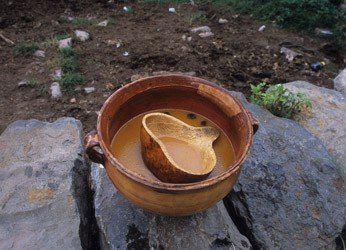
Tongba (India and Nepal)
Strength: 6-8 degrees
Price: Rs 10
Attraction mountain of Nepal and the adjacent Indian states of Sikkim and Darjeeling, tongba made from cooked and fermented millet. The resulting porridge flavored with herbs and left to dry for a period of one to six months, after which the basis for tongby ready. Drink it hot, from special polished wooden mugs: mug filled with millet poured boiling water and drink through a straw is pulled from the filter, pouring boiling water (usually tongba withstand up to six zavarok).
Tongba strength and taste a bit like ale, but with a pronounced taste of sour bread. It is not too strong, but it is easier to drink than it seems, especially in the highlands. In addition, due to different degrees of quality and taste of fermented millet tongby it varies widely from village to village, and alco-trip to the Nepalese mountains with tasting purposes can be compared with the trip of a Scottish distillery. In Nepal, Tibet and Bhutan also do like tongbu chaang sour drink - not out of millet and rice or barley and ginger. According to legend, especially amateurs chaanga considered the Yeti, which are often searched the mountain villages in search of booze.
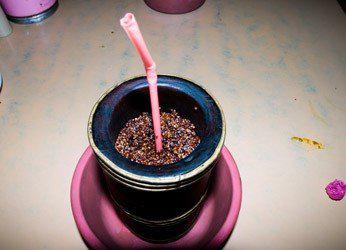
Pulque (Mexico)
Strength: 5-8 degrees
Price: $ 0 60
Manufacturer Website: www.pocotequila.com
People Mexican drink made with a thousand years of history from the fermented juice of the agave. According to one legend, he invented pulque divine opossum who accidentally crawled deep into the thickets of agave, draw some yourself fermented juice got drunk and became the first creature in the universe. According to another myth, the god of pulque agave gave the world Mayahuel and juices collected on the leaves of agave - is her blood. It is also worth mentioning Mayahuel children, known as the Aztecs Tsentzontotochtin, ie "400 rabbits." These sacred rabbits - the gods drink, and everyone is responsible for the different stages of intoxication.
Sacred Bunny hangover actively drumming on the heads of the Mexicans until the beginning of XX century. In Aztec times pulque was considered a sacred drink - drink it could only priests and nobility during ritual celebrations, as well as the elderly and pregnant women. Later, pulque became accessible to all, and in the XVIII century for its production made his fortune many Mexican aristocrats. By the beginning of XX century in one of Mexico City was a few hundred "pulkery" - bars, which served pulque, and Diego Rivera argued that the signs and wall panels, which were decorated with pulkerii - it is best that gave the world of Mexican art.
Mortal Strike pulque caused the growing popularity of beer, which began arriving in Mexico to promote immigrants. Pulque very quickly was considered vulgar drink and gradually went out of fashion. Last but not least it influenced brewers to actively disseminate the rumors that the production of pulque in the vats with the juice of the agave dipped canvas bags of excrement to enhance fermentation - a practice that really has been a while in the course in remote areas of Mexico.
Today the production of pulque is in decline, and not just in the complex process of preparation. Pulque hardly be transported, and all attempts to release commercial versions of pulque in bottles and cans special failed. Unlike tequila, which is also made from the agave plant, pulque has not become a worldwide phenomenon - Jar version (produced under the label Nectar del Razo) is inferior to fresh pulque. Besides its vegetable flavor, tart and sour, most Europeans do not understand. Today the consumption of pulque is less than 10 percent of the total amount of alcohol consumed in Mexico, and the only hope for tourists: tours of the Hacienda pulque-XVII century are beginning to use the increasing demand.
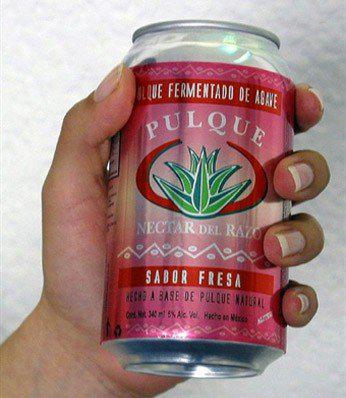
Jandia (India)
Strength: 8-10 degrees
Price: Rs 4-5
Drink tribes living in the Chota Nagpur Plateau in eastern India, is made from fermented rice, local herbs and hay. The main component of Jandia - briquettes "wound" that is made of six types of wood bitter herbs and roots. The collected and dried herbs triturated then mixed with rice flour and rolled into small balls that are left for a few days to dry in the sun. Properly cooked wound checked, throwing into the fire: briquette should break out and burn without residue. The finished wound mixed with rice and boiled, and the resulting mess is left to ferment in the sun for two days in special earthenware vats. Pressed after fermentation turbid liquid fortress 8-10 degrees - this is Jandia. Handa cooked only women, and in the process of cooking they are forbidden to speak. If Jandia made for ritual purposes, women need to do the washing in the morning and change at all clear.
At Jandia most controversial reputation of all Indian alcoholic beverages: the tribes believe that this is the most useful drink in the world, which is especially good in the summer, because he "cools the stomach." It is believed that one of Jandia can safely survive a few days, besides it helps to illumine the consciousness. Nevertheless, among the Europeans there are persistent rumors of serious poisoning and other unpleasant cases of Handa: how herbs are included in the "wound" no one seriously studied.
via
Source:
Fortunately, with the help of the Internet it is impossible to drink, and the world is still full of alcoholic beverages, which can not try anywhere but in their homeland. Some of these drinks can not be transported, while others are manufactured offensively small circulation, others are so amazing that they dare to drink a few.
And together they add up to an alternate universe of alcohol where drinking - it is still a private affair a person with a glass at the bar. Even if the role of the bar covered with clay takes the table, instead of a glass - wooden circle, and splashing in her drink from fermented millet. Forbes.ru chose 10 of the most bizarre world of alcoholic beverages, which are worth a try.

Karlsson's Vodka (Sweden)
Strength: 40 degrees
Price: $ 40
Manufacturer Website: www.karlssonsvodka.com
This Swedish vodka made entirely of Swedish potatoes and, most importantly, on the patterns of wine production: that is, taking into account the terroir, variety of potatoes and crop year. Karlsson's Gold came up with one of the creators of Absolut vodka Borje Karlsson; He came up with the Swedish potato called "golden grapes Swedish land." It is in every sense a contemporary product, rethink all the basic principles of vodka mythology. Standard vodka must not be my taste - Karlsson's, by contrast, emphasizes the difference flavors of different harvest years. In line Karlssons Vintage far presented three years (2004, 2005 and 2006), and there are both single-malt varieties (made from one type of potato) and mixed blends (Karlssons Gold and Karlssons Gold 25). In particular, there is a vodka made from potatoes, young, growing at Cape Biar.
Each bottle is numbered, each attached to a booklet identifying the locus of potatoes, variety of features, the history of the farm-products and a description of the weather in a given year. Beta testers assured that the taste of vodka of different years and even more made from different varieties really are very different: some more earthen tones, others - fruit.
While Karlsson's just beginning to conquer the world market, but has managed to make some noise in New York, where she served in the trendy East Village bars - mainly due to the benevolent reviews in the New York Times. By the way, for the faint of heart apocryphal Karlsson produces 25-degree version of its potato product.

Bilk (Japan)
Strength: 5 degrees
Price: ¥ 380
Manufacturer Website: www.takahasi.co.jp
Japan holds a confident first place on the number of drinks that can unpleasantly surprise of Western man. It is a country where there is a cucumber "Pepsi", and Coca-Cola produces soda aroma of green salad. There is - and is a success - a drink that imitates the taste of mother's milk, pop flavored eel and low-calorie drink from pig placenta with peach flavor (it is believed that it improves the complexion). Is your marketing findings in the beer industry: very good selling non-alcoholic "beer baby» (Kid's Beer) with a cheerful baby on the label, beer flavored chocolate and regional beer with small sardines from Kanagawa Prefecture.
However, louder than the others were able to express themselves brewers from Hokkaido who produced milk beer Bilk, made up two-thirds of the beer, and a third - from milk. He invented a new beer son of the manager of alcohol shops in nakashibetsu when in March 2006 on dairy farms of Hokkaido happened overproduction of milk. The young man decided to rectify the situation and agreed with the brewery Abashiri Beer, famous for its colored beers - blue, green and red. Beer with milk, require the development of a fairly complex formulation (the milk, low boiling point and high starch content, so that they replace the water was not easy), suddenly received a warm welcome by the locals. Milk beer was considered an easy, enjoyable drink, bringing junk milk have been saved, and the brand Bilk suddenly resounded all over the world.
However, this International triumph awaits him almost: taking the English title (Bilk - this beer + milk), the Japanese are traditionally lazy to look into the English vocabulary: the verb to bilk means "puff", "obegorivat."

Sam Adams Utopia Beer (US)
Strength: 27 degrees
Price: $ 150
Manufacturer Website: www.samueladams.com
This beer is sold under the slogan "the strongest beer in the world" - it 27 degrees. American Brewery Boston Beer Company has long been experimenting in this genre: to release them Utopia Beer brewed beer Triple Bock, and Millenium with an alcohol content of 17, 5 and 21 degrees, respectively. Beer Utopia appeared in 2002 and at first was issued fortress 24 degrees, but then the Brewers added three more.
Of course, this beer is not too similar to beer - it is positioned as a digestif, and the taste is more like a bitter busy port. It is brewed from Vienna, Moravian and Bavarian malts and four kinds of hops with the addition of maple syrup and then aged at least a year in barrels of cognac, port and sherry. This small run beer: in 2009 it was brewed about 53 barrels (12 000 bottles). Utopia Beer is produced in special flasks capacity 0, 75 l, resembling copper beer kegs, and sold an average of $ 150. It occurs infrequently, in addition to the 14 states a beer of this strength may not be sold legally.
It is worth mentioning that the title "the strongest beer in the world" for marketing reasons are trying to seize other brewery - especially eloquent fight Schorshbrau German brewery Scottish and Brew Dog. In December last year released Schorshbrau beer strength of 40 degrees, Brew Dog in May 2010, killed their rate 41-degree beer with a suitable name Sink the Bismarck, and in the same month Schorshbrau said 43-degree Schorschbock. In the world of brewers of this arms race watched with interest, but beer lovers have not yet decided whether it is worth to consider these drinks beer.

Mamma Mia Pizzabeer (US)
Strength: 4, 6 degrees
Price: $ 2, 50
Another specific Hand crafting a beer - this time with the taste of pizza. This product is a small family brewery from Illinois, whose owners - Tom and Athena Sifurt - do not hide that inspired book Radical Brewing Chicago designer and amateur brewer Randy Mosher. Largely because of the influence of Mosher in America spread the fashion for private brewery experimenting with the recipes - they brew a beer with maple syrup, pepper, coriander, hemp, honey and garlic (from Mosher, by the way, are mentioned far more strange things: mushrooms, Crab eyes and heated pebbles).
Mamma Mia Pizzabeer - is, strictly speaking, a beer flavored oregano, tomatoes, garlic and basil. The oddity is that in its manufacture couple Sifurtov does use a pizza margarita. Freshly milled pizza to mush, put into a linen bag and a long brewed in boiling water as a tea bag. Then infusion of drained and cooked it more or less classic ale. Almost all tried Mamma Mia Pizzabeer celebrate strong and instantly recognizable scent of pizza - and even stronger garlic aftertaste.

Spruce beer (Canada)
Strength: 5 degrees
Price: $ 5, 80
Manufacturer Website: www.wigrambrewing.co.nz
In spruce beer - a beverage brewed from fresh twigs containing added sugar or molasses - a long history: until the beginning of the XX century it actively brewed in America, Canada, Scotland and Scandinavia. Spruce beer made with sugar on his ship even Captain Cook believes that it is very good for scurvy. In spruce beer was excellent reputation: in the XVIII century it was supplied to the army battalions, and its preferred rum. A letter of the British Vice Admiral Samuel Graves, dated 1775 the year in which he urges the soldiers and sailors drink is beneficial to the health of spruce beer, not rum, awakens in man the most evil tendencies.
In the French provinces of Canada spruce beer brewed privately until 1940, and later the Canadian branch of the "Phantom" even let fir non-alcoholic drinks, and many Quebecers that taste is still strongly associated with childhood. Today, their business continues to small Canadian company Marco Beverages, making pop tastefully pine branches.
But now spruce beer brewery brews only one in the world - New Zealand Wigram Brewing Co: they claim that it is using the recipe in 1773. This dense drink with a very strong smell of pine and unexpected taste of tea (as part of the beer there Manuka tea tree). Despite running a viral advertising that tried to promote spruce beer as a national drink of New Zealand, it is a hit or not, and in one of the reviews called it "a cocktail of toothpaste, damp marsh tea and sleep."

Chicha (Latin America)
Strength: 3-50 degrees
Price: depending on the country, the quality and strength of the drink
This is a very ancient drink - drank more Incas. On the antiquity points and the method of production: in the traditional version of the woman chewed dry grain maize yellow or purple, and the resulting mass is poured with water and left to ferment until the desired fortress. Enzymes in the saliva digested corn starch, turning it into maltose - so (chewing grains) used to do, and many other beverages, such as sake.
Species chicha there are so many. In the Amazon chicha made from cassava, chicha in Bolivia cook amaranth in Colombia and Ecuador - from quinoa, rice and pineapples. Most rare variety - "chicha de Mall", which makes in the Peruvian city of Huanta of the fruit of the tree of the local mall (we better known as pink pepper). "Chicha de Molay" differs from other particularly delicate taste and is believed to be the most monstrous hangover ever known to mankind.
Fortress chicha is also very different from soft drinks to nearly 50-degree. However, in spite of the rich history, the tradition of drinking chicha is now in decline - not least due to the peculiarities of its preparation. In many countries, it is exposed to persecution, as officials reasonably believe it peddler diseases; In particular, the Bolivian government launched agitprogrammu "You drink chicha - to spread TB." Find traditional chicha of chewing grains and spitting is now the easiest way in the mountain villages of Bolivia, Ecuador, Colombia and Costa Rica, where it is a tray for all guests.
However, there is a version of bottled soft drinks chicha maize, which is done by provarivaniya red cobs of maize with pineapple, cinnamon and cloves, and which can be found even in the States. In Chile, selling bottled grape and apple chicha - a nasty 8-degree tangle-legs having relatively little to do with real corn chicha.
However, there is a possibility that the chicha is waiting for a rebirth - the extreme of American brewers Dogfish Head Brewery last year brewed chicha 10 kegs firm, with the help of volunteers chewed 10 kg of dried Peruvian corn.

Tongba (India and Nepal)
Strength: 6-8 degrees
Price: Rs 10
Attraction mountain of Nepal and the adjacent Indian states of Sikkim and Darjeeling, tongba made from cooked and fermented millet. The resulting porridge flavored with herbs and left to dry for a period of one to six months, after which the basis for tongby ready. Drink it hot, from special polished wooden mugs: mug filled with millet poured boiling water and drink through a straw is pulled from the filter, pouring boiling water (usually tongba withstand up to six zavarok).
Tongba strength and taste a bit like ale, but with a pronounced taste of sour bread. It is not too strong, but it is easier to drink than it seems, especially in the highlands. In addition, due to different degrees of quality and taste of fermented millet tongby it varies widely from village to village, and alco-trip to the Nepalese mountains with tasting purposes can be compared with the trip of a Scottish distillery. In Nepal, Tibet and Bhutan also do like tongbu chaang sour drink - not out of millet and rice or barley and ginger. According to legend, especially amateurs chaanga considered the Yeti, which are often searched the mountain villages in search of booze.

Pulque (Mexico)
Strength: 5-8 degrees
Price: $ 0 60
Manufacturer Website: www.pocotequila.com
People Mexican drink made with a thousand years of history from the fermented juice of the agave. According to one legend, he invented pulque divine opossum who accidentally crawled deep into the thickets of agave, draw some yourself fermented juice got drunk and became the first creature in the universe. According to another myth, the god of pulque agave gave the world Mayahuel and juices collected on the leaves of agave - is her blood. It is also worth mentioning Mayahuel children, known as the Aztecs Tsentzontotochtin, ie "400 rabbits." These sacred rabbits - the gods drink, and everyone is responsible for the different stages of intoxication.
Sacred Bunny hangover actively drumming on the heads of the Mexicans until the beginning of XX century. In Aztec times pulque was considered a sacred drink - drink it could only priests and nobility during ritual celebrations, as well as the elderly and pregnant women. Later, pulque became accessible to all, and in the XVIII century for its production made his fortune many Mexican aristocrats. By the beginning of XX century in one of Mexico City was a few hundred "pulkery" - bars, which served pulque, and Diego Rivera argued that the signs and wall panels, which were decorated with pulkerii - it is best that gave the world of Mexican art.
Mortal Strike pulque caused the growing popularity of beer, which began arriving in Mexico to promote immigrants. Pulque very quickly was considered vulgar drink and gradually went out of fashion. Last but not least it influenced brewers to actively disseminate the rumors that the production of pulque in the vats with the juice of the agave dipped canvas bags of excrement to enhance fermentation - a practice that really has been a while in the course in remote areas of Mexico.
Today the production of pulque is in decline, and not just in the complex process of preparation. Pulque hardly be transported, and all attempts to release commercial versions of pulque in bottles and cans special failed. Unlike tequila, which is also made from the agave plant, pulque has not become a worldwide phenomenon - Jar version (produced under the label Nectar del Razo) is inferior to fresh pulque. Besides its vegetable flavor, tart and sour, most Europeans do not understand. Today the consumption of pulque is less than 10 percent of the total amount of alcohol consumed in Mexico, and the only hope for tourists: tours of the Hacienda pulque-XVII century are beginning to use the increasing demand.

Jandia (India)
Strength: 8-10 degrees
Price: Rs 4-5
Drink tribes living in the Chota Nagpur Plateau in eastern India, is made from fermented rice, local herbs and hay. The main component of Jandia - briquettes "wound" that is made of six types of wood bitter herbs and roots. The collected and dried herbs triturated then mixed with rice flour and rolled into small balls that are left for a few days to dry in the sun. Properly cooked wound checked, throwing into the fire: briquette should break out and burn without residue. The finished wound mixed with rice and boiled, and the resulting mess is left to ferment in the sun for two days in special earthenware vats. Pressed after fermentation turbid liquid fortress 8-10 degrees - this is Jandia. Handa cooked only women, and in the process of cooking they are forbidden to speak. If Jandia made for ritual purposes, women need to do the washing in the morning and change at all clear.
At Jandia most controversial reputation of all Indian alcoholic beverages: the tribes believe that this is the most useful drink in the world, which is especially good in the summer, because he "cools the stomach." It is believed that one of Jandia can safely survive a few days, besides it helps to illumine the consciousness. Nevertheless, among the Europeans there are persistent rumors of serious poisoning and other unpleasant cases of Handa: how herbs are included in the "wound" no one seriously studied.
via
Source:











